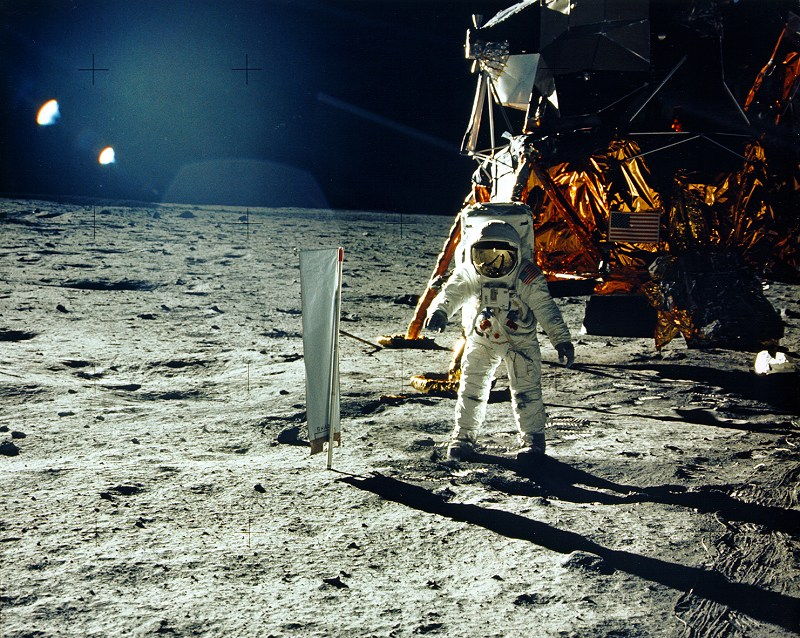Tom Hanks Flies Alan Bean to the Moon in 'The New Yorker'

There's a certain irony to the observation that Tom Hanks today may be better known for flying to the moon than Alan Bean, who actually went there.
The actor and director, who starred as an astronaut in the feature film "Apollo 13" and helmed the miniseries "From the Earth to the Moon," celebrates Bean and laments the real astronaut's relative anonymity in the current issue of "The New Yorker," now on magazine stands. In addition to taking part in an interview, Hanks contributes an original, fictional short story, titled "Alan Bean Plus Four."
"I named the capsule the Alan Bean, in honor of the lunar module pilot of Apollo 12, the fourth man to walk on the moon and the only one I ever met," the narrator in Hanks' story explains of his and his three crewmates' moon-bound spacecraft. "He was paying the cashier, as anonymous as a balding orthopedist, when I yelled out, 'Holy cow! You're Al Bean!' He gave me his autograph and drew a tiny astronautabove his name." [NASA's 17 Apollo Moon Missions in Pictures]
Read "Alan Bean Plus Four" on The New Yorker website.
In real life, Bean really did become the fourth man to walk on the moon 45 years ago this November. Since returning from space, Bean has become an artist, painting his and his fellow astronauts' experiences on the moon.
Hanks, since returning from his own on-screen journeys to the moon some 15 years ago, has gone on to perfect his own art, which now extend to writing fiction.
"I've been around great storytellers all my life and, like an enthusiastic student, I want to tell some of my own," Hanks said.
Breaking space news, the latest updates on rocket launches, skywatching events and more!
In "Alan Bean Plus Four" (the title an homage to a sign aboard the USS Hornet aircraft carrier after recovering the Apollo 11 astronauts post-splashdown), Hanks imagines a bootstrap flight around the moon and back, thought up over beers and achieved for the fun of it. Cobbled together from spare parts and iPhone apps, the mission reflects the nonchalant attitude the public seemingly applies to the space feats of yesterday, and today.
"Travelling to the moon was way less complicated this year than it was back in 1969, as the four of us proved, not that anyone gives a whoop," Hanks' narrator begins.
Of course, Hanks doesn't actually believe that.
Enthralled as a child by the space achievements of a half-century ago, Hanks tells "The New Yorker" that he doesn't think anyone will go back to the moon for a few hundred years. "Such things take time," he comments, citing the "complicated combination" needed to go, including money, development, lots of work, the reason to go and the will to make it happen.
Even more reason, Hanks opines, why Alan Bean should be a household name.
"Among NASA folk, Al Bean is a legend," Hanks said. "But what he (and the others) did deserves more attention — more fanfare, perhaps — than he/they have received. So says me, anyway."
Click through to collectSPACE to listen to Tom Hanks’ read his short story, “Alan Bean Plus Four.”
Follow collectSPACE.com on Facebook and on Twitter at @collectSPACE. Copyright 2014 collectSPACE.com. All rights reserved.

Robert Pearlman is a space historian, journalist and the founder and editor of collectSPACE.com, a daily news publication and community devoted to space history with a particular focus on how and where space exploration intersects with pop culture. Pearlman is also a contributing writer for Space.com and co-author of "Space Stations: The Art, Science, and Reality of Working in Space” published by Smithsonian Books in 2018.
In 2009, he was inducted into the U.S. Space Camp Hall of Fame in Huntsville, Alabama. In 2021, he was honored by the American Astronautical Society with the Ordway Award for Sustained Excellence in Spaceflight History. In 2023, the National Space Club Florida Committee recognized Pearlman with the Kolcum News and Communications Award for excellence in telling the space story along the Space Coast and throughout the world.



